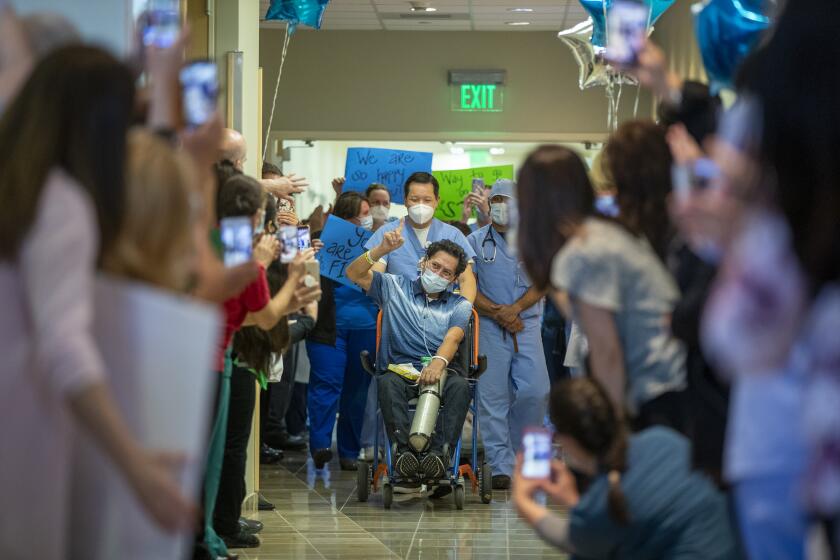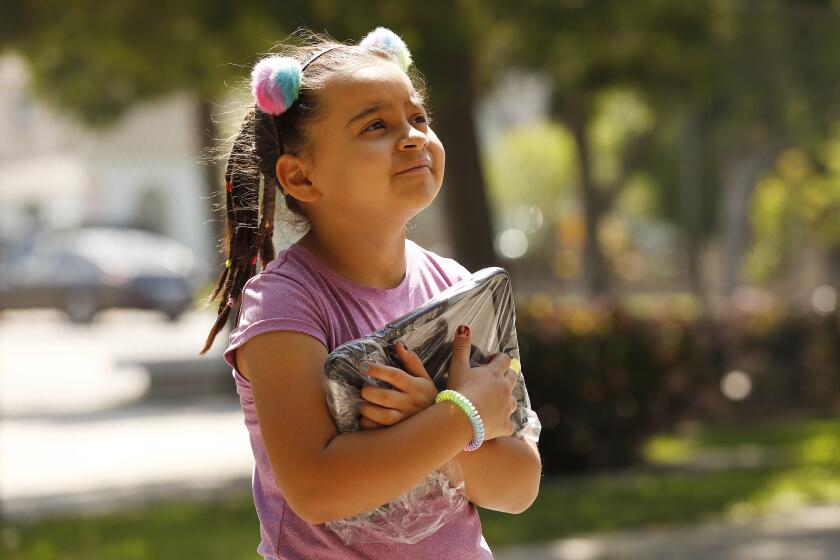One teacher’s quest to track down her students amid coronavirus school closure
- Share via
By Friday morning, only eight of Keara Williams’ 24 Advanced Placement English students had submitted the assignments she posted online after school closed three weeks ago.
Most of the remaining two-thirds of the juniors in her class at a South L.A. high school had not responded to any of her messages.
These 16 were among the thousands of Los Angeles Unified high school students who have not been showing up to online classes. By end of last week, the school district had not made contact with 7%, or about 8,400, of high school students since campuses shut down on March 16, marking an improvement from earlier when about 15,000 had not joined online classes.
Teachers, counselors and administrators are trying to get those students back. Many students, meanwhile, are telling teachers they receive emails about Zoom calls hours late through the district’s system, and the program they use to check for work does not always show them posted assignments on time. Others lack WiFi access at home and many are helping their families care for younger siblings.
Williams spent an hour Friday, as she has on many other days since school closed, focused on trying to reach her absent students. Williams has received a “building bridges” award from her school, a recognition that she is particularly skilled at creating and maintaining relationships with students and families in and out of the classroom.
These are some of the unusual new scenes across the Southland during the coronavirus outbreak.
That may make it easier for her to connect with them when school is out, said Williams, who works at the Responsible Indigenous Social Entrepreneurship school, one of three small schools on the Hawkins High School campus in South L.A.’s Vermont-Slauson neighborhood.
“There’s a lack of black teachers in LAUSD alone and just teaching period,” Williams said. “I think the fact that I’m black, I’m from the community... I’m cultured. I think all of that helps me build my relationships with them,” she said.
About a fourth of students in the school are black — a higher percentage than in the district as a whole — and three-fourths are Latino.
After a few calls went straight to voicemail, and one message left with a student’s brother, Williams reached a parent. But there was a problem — the mother only spoke Spanish and Williams is not fluent.
After a few minutes of trying to communicate that she is the English teacher calling to check in on schoolwork, Williams asked the parent to hold — and called her grandmother, a native Spanish speaker from Belize. Her grandma picked up immediately and agreed to translate on a three-way call.
Within minutes, the two Spanish-speakers understood what needed to be done — the student was not completing work for English and needed to call Williams. The parent was at work but said she would call home and tell her daughter to call the teacher.
“I’ve got to pool all my resources right now,” Williams said after the call.
About 25 minutes into her search for missing students, feelings started to set in.
“I miss my kids. I miss them so much. I just want to... I want to help them. I want to teach them. I think I’m getting a little emotional,” Williams said. “I wish I was in a class and I wish I had my white board and my marker and I wish I had all of them in one room because it is not easy,” she said before collecting herself with a deep breath. “Ok, so. Whew, all right. Should we move on?”
On to the next call. A student’s mother answered.
“I was calling to see ... if you had internet access or a computer because I’ve noticed that he hasn’t been submitting his work online,” Williams told the parent. “So I was calling just to check in and see what’s going on, maybe he needs help, maybe he has questions?”
The mom called for her son to come to the phone. It was 11:20 a.m. and he was still in bed.
When he came on, Williams greeted him the same way she had another student — exclaiming his name, followed by a robust “How are you?”
“Oh, you just woke up. I’m sorry sir,” she said, sounding contrite before changing up her tone. “It’s 11:20! What are you doing?”
She said she wasn’t angry, and when he said he was good and asked her the same, she was honest.
“I’m kind of bored in the house, you know, I cook a lot, but I just want to go outside,” she said. “What have you been doing in the house?
Playing PlayStation 4 and watching Netflix, he said.
“I think you’re telling the truth because, you know, you haven’t submitted any assignments online,” she responded.
He thought he missed the deadline so didn’t bother submitting, he told her.
“That’s four grades man! Anyway, I’m going to stop yelling at you,” she said after listening to him.
“Maybe you don’t watch Netflix today and maybe you finish a draft,” she negotiated. “Send it to me... I can look at and give you feedback. You can strengthen it and then I can grade it.”
“So you commit to doing it today? A draft?” she urged him, also promising to post another student essay sample for him to look at.
She told him to check in with two classmates she knows are his friends, who have submitted the assignment. She asked him about other classes, and then circled back to her own.
L.A. school chief says district is moving fast to set everything up and racing to find unconnected students. The number drops substantially in a week.
“We are being more flexible because we understand that remote learning is different. So our deadlines aren’t really real deadlines right now as we try to figure out what we’re doing next,” she told him. “So check your emails for that, but in the meantime, please complete all your missing work because you can get it graded.”
After securing the promise to get his overdue work, Williams ended the call as cheerily as she had started it. “Ok sounds good, miss you so much!”
Some of the other parents she called did not pick up and had voicemails in Spanish — she didn’t leave messages for those numbers. Instead she made a note of them in the school’s system and will pass their names onto the school’s counselors, all of whom are bilingual and will reach out, she said.
Another student had a device from school, his sister told Williams, but no internet — that’s why he hasn’t been submitting work. She took the sister’s email address to send a phone number that they can call to request internet access provided through the school district.
“I can call you maybe in a couple of days to follow up to see how it went,” Williams told her. “So if you have any other questions, please reach out to me and I can talk to my principal.” She hung up and made a note to herself — “Send hotline number, don’t focus on work, just getting internet.”
She wants to make sure that students are not penalized because they don’t have internet access.
“Now what I would do is send an email to teachers,” she said, “letting them know that he does not have the WiFi.... Let’s as a team figure out how to get him internet.”
Two other students — including the one whose mother spoke to Williams’ grandmother — called Williams back after family members delivered the message. Now that she’s started calling these AP students, she expects more will get in touch.
“I just have a feeling that the word’s going to spread that Ms. Williams is calling home, like it always does,” she said. “That means that they’ll probably try to email me before I call home.”
Times staff writer Howard Blume contributed to this story.
More to Read
Sign up for Essential California
The most important California stories and recommendations in your inbox every morning.
You may occasionally receive promotional content from the Los Angeles Times.
















